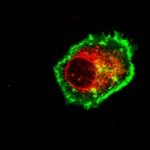Link to Pubmed [PMID] – 19806033
Channels (Austin) 2009 Nov;3(6):383-6
The Na(+),K(+)-ATPase pump achieves thermodynamically uphill exchange of cytoplasmic Na(+) ions for extracellular K(+) ions by using ATP-mediated phosphorylation, followed by autodephosphorylation, to power conformational changes that allow ion access to the pump’s binding sites from only one side of the membrane at a time. Formally, the pump behaves like an ion channel with two tightly coupled gates that are constrained to open and close alternately. The marine agent palytoxin disrupts this coupling, allowing both gates to sometimes be open, so temporarily transforming a pump into an ion channel. We made a cysteine scan of Na(+),K(+)-ATPase transmembrane (TM) segments TM1 to TM6, and used recordings of Na(+) current flow through palytoxin-bound pump-channels to monitor accessibility of introduced cysteine residues via their reaction with hydrophilic methanethiosulfonate (MTS) reagents. To visualize the open-channel pathway, the reactive positions were mapped onto a homology model of Na(+),K(+)-ATPase based on the structure of the related sarcoplasmicand endoplasmic-reticulum (SERCA) Ca(2+)-ATPase in a BeF(3)(-)-trapped state,(1,2) in which the extra-cytoplasmic gate is wide open (although the cytoplasmic access pathway is firmly shut). The results revealed a single unbroken chain of reactive positions that traverses the pump from the extracellular surface to the cytoplasm, comprises residues from TM1, TM2, TM4 and TM6, and passes through the equivalent of cation binding site II in SERCA, but not through site I. Cavity search analysis of the homology model validated its use for mapping the data by yielding a calculated extra-cytoplasmic pathway surrounded by MTS-reactive residues. As predicted by previous experimental results, that calculated extra-cytoplasmic pathway abruptly broadens above residue T806, at the outermost end of TM6 that forms the floor of the extracellular-facing vestibule. These findings provide a structural basis for further understanding cation translocation by the Na(+),K(+)-ATPase and by other P-type pumps like the Ca(2+)- and H(+),K(+)-ATPases.
